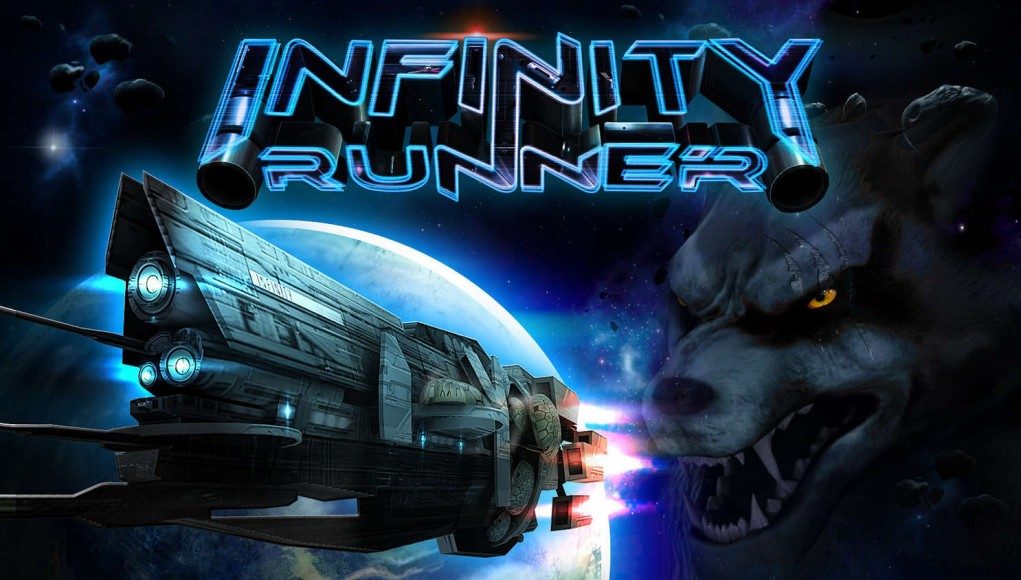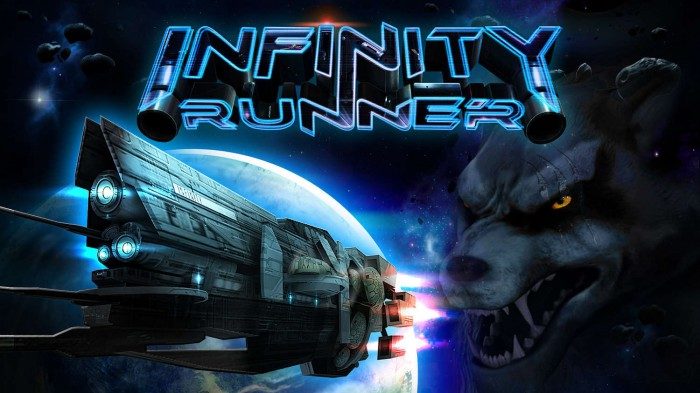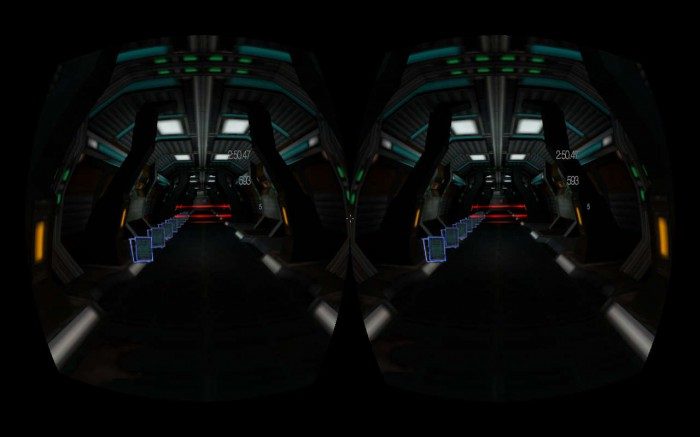Today Wales Interactive launches Infinity Runner, which is exactly what it sounds like—an infinite running game like many found on mobile platforms. The team appears to have successfully ported the genre from mobile to PC, but does it work as a virtual reality game for the Oculus Rift?
Infinity Runner has launched today on Steam and is currently available for $8.99.
The Infinity is the largest spaceship ever built by man-kind; flung into the void of space to secure humanity a new home amongst the stars. However, instead of discovering paradise, the inhabitants of The Infinity unlocked the door to a long forgotten nightmare.
Deep inside this leviathan something terrible hunts, out of myth and legend the last werewolf stalks the ship. Infinity Runner centres on a prisoner desperately trying to escape the decaying ship and the clutches of the terror within. It’s a sci-fi action running game for PC, Mac, and Linux that features 14 stunning levels, Oculus Rift support and multi-player.
Aspiring VR developers, take note: Infinity Runner is a textbook case of what not to do in a VR game.
Gameplay
Infinity Runner is a first person running game. It shares all the usual tropes you’d expect from the mobile genre: three lanes to run in, corners to turn, obstacles to dodge, jump, and slide under, and something akin to lines of coins to collect (in this case it’s data files). There are a few sequences that mix things up a bit like a cylindrical no-gravity hallway where you can run in a spiral as you go forward and a shaft down which you free fall like a sky diver.
Story Mode starts with the player breaking out of a cryo-chamber of sorts. From here you’re slowly introduced to the various game mechanics which include segments where you “fight” guards with a quicktime event that requires a series of button presses and mouse clicks.
As you learn to tackle various obstacles, you eventually come across a power-up which turns you into an enraged werewolf (apparently your ability to do this was the subject of experimentation at the facility that you are trying to escape). This mode works a bit like the magnet powerup in other running games, as you are wide enough to collect data files from all three running lanes. Werewolf mode allows you to effectively skip guard fights by killing your opponents automatically. As a werewolf, there are also several different mechanics, including the ability to break through weak walls (leading to the cylindrical no-grav segments), along with some wall running moments that get you passed pits of toxic slime.
At one point you encounter an enemy werewolf who chases you along your path. This surely could have been one of the more exciting parts of Infinity Runner in VR, as being able to look behind you while something is chasing you—while still running forward—is a unique function of head tracking. Unfortunately, due to some poor design choices, looking behind you is impossible. The segment amounts to little more than the normal gameplay plus some occasional werewolf noises coming from (ostensibly) behind you.
Visually prompting the player to tell them what to do is very important for running games like Infinity Runner. Nothing is more frustrating than thinking you are supposed to jump when you are instead supposed to slide. I found Infinity Runner to have issue with its visual prompting, leading to lots of trial and error instead of feeling like you have a grasp on the game mechanics.
At several moments in the game a truck would slide out from the side of a certain room. At first it looked clearly like it should be jumped over, but when I tried that, I died. Starting back at the checkpoint, I tried to dodge around to the left, which also lead to my death. On my third attempt, I tried to slide—despite it looking very plainly like I couldn’t fit under the truck. But alas, it worked—yet as my player clipped through the truck, I felt confident that I wasn’t mistaken when initially thinking there wasn’t enough room. Talk about frustrating.
VR Design
From the moment you start Story Mode, the game forcefully takes control of your head by whipping the camera wildly about at nearly every opportunity. As it leads to discomfort, this is about as rude as someone grabbing your head in real life and shaking it around.
At the beginning of the game, your character starts by breaking out of the cryo-chamber, and promptly tumbles to the ground, taking your head—and your horizon—with it. At segments where you fight guards, the same is true; the camera is forced around against your own looking direction as your character executes a scripted attack.
For reasons unknown, the head tracking is limited to a cone that’s approximately 90 degrees across the center. When you turn your head 90 degrees to the left, you hit an invisible head tracking wall of sorts, causing the world to get dragged along with your head the moment you cross it. The same happens on the other side and on the top and bottom. This makes it impossible to look behind you, or much further than 45 degrees in any direction. This essentially neuters one of the most compelling aspects of any VR experience.
There are moments in the game, when running through a big room, zipping across a zipline, or making a big jump through space, that it would be great to look around and be immersed in the environment. Too bad, you’re stuck in that little head tracking cone.
This odd design choice means the Rift is used more like a mere display device than an integral part of the experience. The only aspect of head tracking that is tied into the gameplay is deciding to turn left or right at corners by looking in that direction. And while this implementation technically works, it isn’t very comfortable because of the speed that you turn corners. You have to turn your head to the left or right before you reach the corner to make sure your character turns. As the character hits the 90 degree corners, the world immediately whips around you and you have to turn your head back to forward to compensate, which tends not to be comfortable after successive cornerings. I suggested that the developers look into using head tilt instead of head turn to decide which direction to turn—this way you wouldn’t need to whip your head one direction and then back again after rounding the corner. Ben Tester, Marketing Assistant and Environment Artist at Wales Interative told me, “I will definitely bring up the head turning suggestion with the team but I think this would take a little longer to discuss and implement so although I doubt there will be a change there so soon, it will most definitely be discussed to see what we can come up with.”
The rows of data files that you collect are right about eye-level on certain stages. The feeling of having them fly directly into your face is extremely uncomfortable, not to mention that they obscure your view. After sending feedback to the developers about this, a last-minute patch deployed some small changes to make the data files essentially fade away before they reach your face. This is indeed more comfortable, but that the fly-in-your-face version likely would have launched without my input doesn’t inspire confidence in Infinity Runner’s Oculus Rift implementation being anything more than a bullet-point gimmick.
It seems like anyone with an Oculus Rift would be able to point to a number of severe VR issues with just a few minutes in the game:
The ‘Show Crosshair’ option in the Oculus Rift menu (which defaults to ‘No’) is overridden by the same option in the graphics menu (which defaults to ‘Yes’).
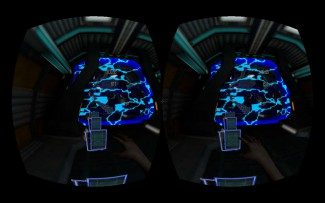
The in-level UI, which is effectively stuck to your face, doesn’t converge at all, giving you double-vision on the UI elements as you play. This is particularly bothersome as it’s very difficult to read the training prompts as you go, leading to much trial and error as you try to learn new mechanics.
Checkpoints take the form of glowing blue force fields that clip straight through your face as you run through them. Pro tip for VR developers: clipping things through the player’s face is never comfortable.
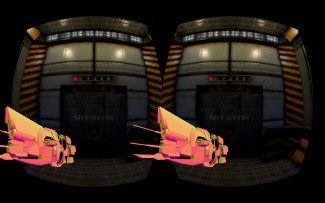
Each time you launch the game and start a level, there’s a massive glitched artifact attached to your face until you start running (you can see it at the beginning of the video above). The loading screen isn’t Oculus Rift enabled, so you get greeted with two totally different images in each eye between levels.
The real cherry-on-top for bad VR design is the werewolf mode. When you get this power-up, your character starts sprinting on all fours, complete with your head bobbing wildly up and down as you go. This doesn’t just make it more difficult to play, as it’s hard to see when the world is bobbing up and down in front of you (especially with the Oculus Rift DK1’s motion blur), it’s also extremely uncomfortable for the eyes and head.
I spent more than an hour straight in Infinity Runner. I reached a part where I became a werewolf and had to jump onto the wall. For reasons unknown, my character kept falling off of the wall and to his death in the toxic sludge below. Each time I died, I would start back at the checkpoint, become a werewolf again, be subjected to the head bob, then fall off the wall and die. After doing this about ten times, I had to quit. The head bob was just too uncomfortable. I will tell you now that I didn’t finish story mode because of this particular event.
The overall VR user experience is very poor as the main menus of the game do not support the Rift. This means you have to jump in and out of the Rift to make level and mode selections.
The game is listed on Steam as having SteamVR support, but in my testing, SteamVR didn’t recognize it as a VR title and launched it in 2D instead.
(I hope) It Can Be Fixed
I hate to point out all of this game’s obvious VR design flaws because it’s actually pretty fun. If the myriad of VR issues above were sorted out, Infinity Runner could absolutely work on the Oculus Rift, and would probably be a blast.
One obvious choices might be to move things to third person, so that the player doesn’t have to inhabit the head of the character—which leads to the majority of discomfort in this game. Another option Wales Interactive should look into is what Oculus VR Software Architect, Tom Forsythe, calls “meathook avatars.” Anyone interested can find info about meathook avatars can watch Forsythe’s GDC 2014 talk, starting with the section ‘Animated Avatars.’
I do hope we see the developer take steps to make Oculus Rift support a serious consideration in Infinity Runner, rather than a buzzword or marketing bullet-point. As a day-one release, however, this game is not ready for VR.
Infinity Runner Score
Gameplay: 7.0
VR Design: 3.0
Overall: 5.0

